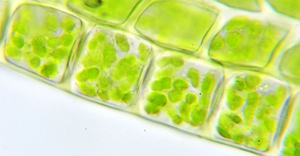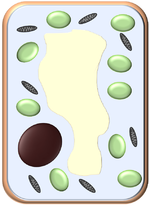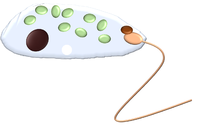Chloroplast
Contents
Key Stage 3
Meaning

The small green chloroplasts can be seen inside these cells.
Chloroplasts are a part of some cells that uses photosynthesis to make food for the cell.
Function
- The chloroplasts make food for the plant using photosynthesis.
About Chloroplasts
- Chloroplasts are found in many plant cells and in Euglena.
- Chloroplasts contain a green pigment called chlorophyll which allows it to perform photosynthesis.
- The chloroplast is where photosynthesis takes place in a plant.
- Some specialised plant cells do not have chloroplasts, such as Root Hair Cells. This is because they are are underground so they don't get any light for photosynthesis.
Examples
| Palisade Cell | Spongy Mesophyll Cell | Euglena |
| A cell has an elongated shape and lots of chloroplasts for photosynthesis. | A cell found in the middle of a leaf. | A unicellular organism that is neither plant nor animal. |
Key Stage 4
Meaning
Chloroplasts are green organelles found in plant cells that contain chlorophyll and make food for the plant by photosynthesis.
Function
- The chloroplasts make food for the plant by photosynthesis.
About Chloroplasts
- Chloroplasts have their own DNA inside them which suggests they were once an independent organism that migrated into the early eukaryotic cells that became plant cells.
- Chloroplasts are found in most plant cells and in some protists such as Euglena.
- Many chloroplasts are found in the cells in the leaves of plants, particularly the palisade cells.
- Chloroplasts contain a green pigment called chlorophyll which allows it to perform photosynthesis.
- The chloroplast is where photosynthesis takes place in a plant.
- Some specialised plant cells do not have chloroplasts, such as Root Hair Cells. This is because they are are underground so they don't get any light for photosynthesis.
Examples
| Palisade Cell | Spongy Mesophyll Cell | Euglena |
| A cell has an elongated shape and lots of chloroplasts for photosynthesis. | A cell found in the middle of a leaf. | A unicellular organism that is neither plant nor animal. |
References
AQA
- Chloroplast, pages 14, 19, GCSE Biology; Student Book, Collins, AQA
- Chloroplasts, page 11, GCSE Combined Science; The Revision Guide, CGP, AQA
- Chloroplasts, page 7, GCSE Biology; Third Edition, Oxford University Press, AQA
- Chloroplasts, pages 11, 57, GCSE Biology; The Revision Guide, CGP, AQA
- Chloroplasts, pages 24, 144, GCSE Combined Science Trilogy; Biology, CGP, AQA
- Chloroplasts, pages 24, 158, GCSE Biology, CGP, AQA
- Chloroplasts, pages 6, 96, GCSE Combined Science Trilogy 1, Hodder, AQA
Edexcel
- Chloroplasts, pages 11, 47, GCSE Combined Science; The Revision Guide, CGP, Edexcel
- Chloroplasts, pages 12, 69, GCSE Biology; The Revision Guide, CGP, Edexcel
- Chloroplasts, pages 24, 198, GCSE Biology, CGP, Edexcel
- Chloroplasts, pages 5, 124, GCSE Biology, Pearson, Edexcel
- Chloroplasts, pages 5, 86, GCSE Combined Science, Pearson Edexcel


